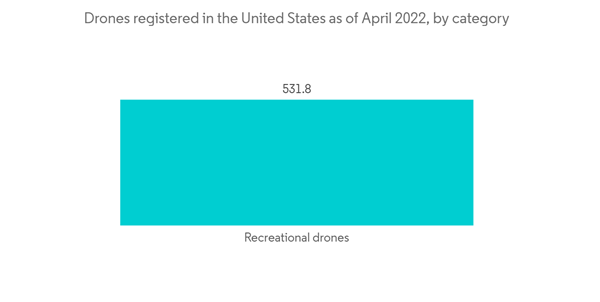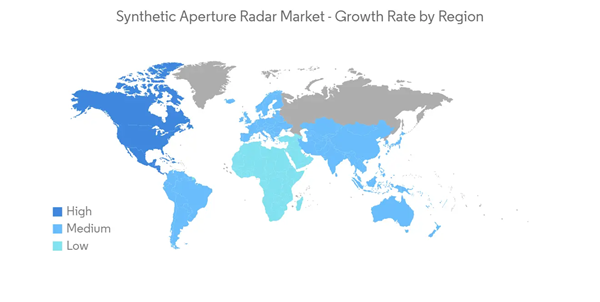The Synthetic Aperture Radar Market size is estimated at USD 5.21 billion in 2024, and is expected to reach USD 8.80 billion by 2029, growing at a CAGR of 11.07% during the forecast period (2024-2029).
The pandemic has led to increased demand for satellite imagery, including the economic impact of the virus and conducting remote monitoring of facilities and infrastructure. Further, the market is witnessing increased demand from the oil and gas industry. For instance, Ursa Space Systems, which offers satellite data and analytics, observed the impact of COVID-19 on global oil inventories as the company provides weekly reports on 11,000 oil storage tanks using SAR satellites.
This product will be delivered within 2 business days.
The pandemic has led to increased demand for satellite imagery, including the economic impact of the virus and conducting remote monitoring of facilities and infrastructure. Further, the market is witnessing increased demand from the oil and gas industry. For instance, Ursa Space Systems, which offers satellite data and analytics, observed the impact of COVID-19 on global oil inventories as the company provides weekly reports on 11,000 oil storage tanks using SAR satellites.
Key Highlights
- With the proliferation of drones, innovation in navigation, and radar systems for Unmanned Aerial Vehicles (UAV) driving, the demand for SAR systems and data is expected to play a vital role, and vendors in the market are expected to focus on expanding their presence in this space. For instance, IMSAR produces low-weight, size, and power synthetic aperture radar systems integrated with uncrewed aerial vehicles and drones; its NSP-3 is an all-weather multi-mode SAR used for land and maritime operations.
- Moreover, the European Union's maritime safety agency (EMSA) also observed an increase in the need for SAR data, especially for its Copernicus Maritime Surveillance program, which offers earth observation products to member governments for law enforcement, fishery management, pollution monitoring, and other applications. EMSA's Copernicus Maritime Surveillance program buys Radarsat-2 data through MDA and TerraSAR-X data through Airbus; it also relies on free SAR data from Europe's Sentinel-1 satellite to detect oil spills under a separate program called CleanSeaNet.
- Over the coming years, the Asia-Pacific region is expected to increase its funding in various military and environmental missions and partner with global players to expand its SAR capabilities further. For instance, the Indian Space Research Organization (ISRO), in partnership with the National Aeronautics and Space Administration (NASA), is launching a dual-frequency synthetic aperture radar NISAR in the last year.
- Despite various advantages of the SAR systems, it is significantly underused compared to traditional optical imagery. To overcome this, the Department of Commerce and the National Oceanic and Atmospheric Administration (NOAA) announced licensing of Private Remote Sensing Space Systems, which revised the regulations for licensing the operation of private remote sensing space systems under the Land Remote Sensing Policy Act of 1992.
Synthetic Aperture Radar (SAR) Market Trends
Growing Demand of Synthetic Aperture Radar in Military and Defense Sector is Driving the Market
- In military applications, a synthetic aperture radar is used to detect surface features, like building complexes, missile sites, and topographical features of the surrounding terrain. Thus, it is used for battlefield surveillance, weapon guidance, and mission planning of future operations.
- The increased military and defense spending enables the defense sector to develop missiles with improved precision targeting. Compared to airborne SAR, missile-borne SAR has various essential characteristics, such as high flight speed with straight movement and a large squint angle, which are crucial in measuring precision in real-time.
- Further, Applications, such as weapons fire-control (missiles or guns) and accuracy control, intelligence, surveillance, reconnaissance missions, air, and spaceborne SAR systems, are expected to witness high adoption of ground-based systems.
- In addition, The United States Air Force used synthetic aperture radar for a bomb damage assessment at Nellis AFB in Nevada. During this test, weapons systems, including F-15Es, F-35s, F-16s, FA-18s, RQ-4, MQ-9, U-2, and joint partners, used SAR Mapping technology to assess the bombs that hit and destroy the intended targets.
- Also, In the defense sector, wide-area surveillance has diverse applications, such as monitoring remote areas for human movement, coast guard vessels, offshore missile platforms, and perimeter security. Technological developments have led to the increasing adoption of Unmanned Airborne Surveillance (UAS) systems or drones.
North America Expected to Witness Significant Growth.
- The United States has one of the most significant national defense budgets and has proactively invested in research and development activities. The defense budget is increasing rapidly each year. For the fiscal year (FY) last year, the defense department proposed USD 715 billion for the Pentagon, an increase of about USD 10 billion. The budget proposal for Pentagon includes the largest-ever investment for research, development, and engineering for USD 112 billion.
- The increasing budgets reflect upon the growing research on the application of synthetic aperture radars in defense. Recently, the United States Air Force Research Laboratory officials at the Ohio base announced a USD 5.2 million contract to the BAE Systems Electronic Systems segment and a USD 4.1 million contract to the Utah State University Space Dynamics Laboratory for the moving target recognition project (MTR).
- In the last year, Satellite designer and manufacturer Terran Orbital Corp. announced that it had received a USD 100 million investment from Lockheed Martin to allow the company to accelerate and expand its manufacturing capabilities.
- Also, the first satellite developed, licensed, and run by ICEYE US was among the fifteenth and 16 synthetic aperture radar (SAR) satellites that ICEYE sent into orbit in January last year. Both satellites were launched from Cape Canaveral, Florida, on the SpaceX Transporter-3 smallsat rideshare mission with Exolaunch.
- Canada is also growing in terms of satellite imaging using SAR for research purposes. The country's space strategy prioritizes acquiring and using space-based data to support scientific excellence, innovation, and economic growth. For instance, MDA Ltd., a Canadian space technology company, recently announced designing and developing of Radarsat-2, the C-band Synthetic Aperture Radar (SAR) satellite. The firm is building the satellite in a public-private partnership with the Canadian government.
Synthetic Aperture Radar (SAR) Industry Overview
The synthetic aperture radar market is moderately fragmented and consists of several international and regional vendors. Moreover, due to relatively moderate product differentiation, the companies are heavily investing in developing strategic decisions to maintain a distinct competitive advantage through collaborations and acquisitions.- June 2022 - After passing testing for integration with the satellite and finally with the launch vehicle, the NASA-ISRO Synthetic Aperture Radar (NISAR) mission payload is planned to be transported to India. For global observations over the whole land mass, including the Polar cryosphere and the Indian Ocean region, NISAR is a combined earth observation program between ISRO and NASA.
Additional Benefits:
- The market estimate (ME) sheet in Excel format
- 3 months of analyst support
This product will be delivered within 2 business days.
Table of Contents
1 INTRODUCTION
4 MARKET INSIGHTS
5 MARKET DYNAMICS
6 MARKET SEGMENTATION
7 COMPETITIVE LANDSCAPE
Companies Mentioned (Partial List)
A selection of companies mentioned in this report includes, but is not limited to:
- Lockheed Martin Corporation
- Airbus SE
- Aselsan A.S.
- BAE Systems Plc
- Cobham Plc (Advent)
- General Atomics Aeronautical Systems Inc.
- L3Harris Technologies
- IMSAR LLC
- Israel Aerospace Industries Ltd
- Leonardo SpA
- Maxar Technologies Ltd
- MetaSensing Group
- Northrop Grumman Corporation
- Raytheon Company
- Saab AB
- SAR AERO
- SRC Inc.
- Thales Group
Methodology

LOADING...










